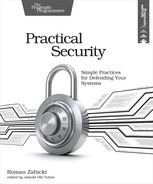Book Description
Most security professionals don't have the words "security" or "hacker" in their job title. Instead, as a developer or admin you often have to fit in security alongside your official responsibilities - building and maintaining computer systems. Implement the basics of good security now, and you'll have a solid foundation if you bring in a dedicated security staff later. Identify the weaknesses in your system, and defend against the attacks most likely to compromise your organization, without needing to become a trained security professional.
Computer security is a complex issue. But you don't have to be an expert in all the esoteric details to prevent many common attacks. Attackers are opportunistic and won't use a complex attack when a simple one will do. You can get a lot of benefit without too much complexity, by putting systems and processes in place that ensure you aren't making the obvious mistakes. Secure your systems better, with simple (though not always easy) practices.
Plan to patch often to improve your security posture. Identify the most common software vulnerabilities, so you can avoid them when writing software. Discover cryptography - how it works, how easy it is to get wrong, and how to get it right. Configure your Windows computers securely. Defend your organization against phishing attacks with training and technical defenses.
Make simple changes to harden your system against attackers.
What You Need:
You don't need any particular software to follow along with this book. Examples in the book describe security vulnerabilities and how to look for them. These examples will be more interesting if you have access to a code base you've worked on. Similarly, some examples describe network vulnerabilities and how to detect them. These will be more interesting with access to a network you support.
